Garden and Clock
- Amy Unfried
- Oct 8, 2018
- 4 min read
Updated: Mar 20, 2019
Sunday I went out by myself for the day, leaving Steve to make as few demands as possible on his healing knee. I busied myself with enjoyable activities different from what we've been doing the rest of the time, which has mostly been Theatre, Food and Friends. (My first activity, actually, did involve food and a friend, and my second one, as you will see if you read that far, could be construed as involving theatre.)
I met my friend Carrie at the Chelsea Physic Garden, which I had never been to before. Carrie lives in London and is a member of the Garden, which she loves and visits with some regularity. It dates back to 1673, founded by Sir Hans Sloane, and is a charitable trust dedicated to the research and propagation of plants. At times in the past its exclusive focus was plants with medicinal uses, but now the various sections of the five-acre preserve cover numerous additional areas of interest, including ferns, poisonous plants, edible plants, South American plants, and a rockery with a pond.
The place is peaceful and beautiful, even when the seasons are changing and there are quite a lot of people visiting it. A free tour was just about to begin when we arrived, so we joined that.
The very knowledgeable guide gave about fifteen people a fascinating tour, and here are some of the many fascinating things we learned: The skin of pomegranates has been used for the covers of books.
After the colony of Georgia was established in 1733, it was unclear what to grow there, and Sir Hans Sloane was the one who suggested cotton and provided the original seeds from the Garden's collection. Joseph Banks, the botanist who accompanied Captain James Cook on his first voyage to Australia (resulting in the names of Botany Bay and the 173 species of the Banksia, which is Australian honeysuckle), wanted to go on the second voyage but made unreasonable demands for scientific equipment and a large entourage of servants and so was denied passage.
In 2010, a London married woman spurned by her lover was convicted of murdering him by sprinkling the highly poisonous seeds of Aconitum ferox (monkshood) on his chicken curry. The garden's fern greenhouse contains within it a second protective enclosure for the most delicate and gossamer ferns that are only one cell thick. When chocolate was first brought to England in the 1650s, people didn't like the bitter taste and would not eat it, but they did mix it with milk and sugar and give it to children for improved nutrition.
The first funguses developed 2.4 billion years ago (b.y.a.), the second major type of life form following stromatolites (sedimentary structures formed by layers of cyanobacteria -- 3.7 b.y.a.; the formation of the earth was 4.5 b.y.a), well in advance of the first algae (1.6 b.y.a.)
Sunflowers were planted in profusion around Chernobyl as phytoremediation following the disaster there in 1986, because the plants leach radiation out of the soil very efficiently. (The guide did not tell us what was then done with the presumably radioactive plants, but it would be easier to remove and dispose of a field-ful of sunflowers than to dig up and transport thousands of tons of earth.)
Harmless and decorative Myrtus odorata (sweet Cicely) can easily be mistaken for Conium maculatum (poison hemlock), a tea of which was the execution method chosen by Socrates.
The Garden includes a large and thriving tree that is a hybrid of a holly and a camellia, and both types of leaves may be found on most of its branches.
There is also a grapefruit tree started from a single pip by a London resident in 1950; by 1970 it had grown too large for her balcony and was transferred to the garden, where it continued to grow; but only in the last couple of years, or maybe only this year, has it borne fruit. (The moral, as the guide told us, is to be patient. Also, eating grapefruit reduces the effectiveness of many modern medications; I was aware of this for statins, but she particularly mentioned Viagra.)
.
After the tour, Carrie and I had a very pleasant and tasty lunch at the Garden's café, after which we walked together to where she had parked her bicycle, and I got a cab to the Tate Modern. It is always an interesting place to visit, and I wandered through a number of its galleries before getting into the queue for a piece I particularly wanted to see some of, a work of film called "The Clock," by Christian Marclay.
I had read a month or so ago in the Jackson Hole Daily, which picked it up from the Associated Press, that the 2010 work was arriving at the Tate Modern; you may have read about it too. It's a 24-hour-long film that is a pastiche of thousands of scenes from films and television shows (in several languages) that show timepieces of all kinds and have to do with time, the passage of time, the importance of time. All the times shown (or mentioned in dialog) occur at the actual precise time of day that the viewer is experiencing. The films are in many cases familiar ones, or use familiar actors, and the result is quite appealing and intriguing. The Tate's auditorium has very comfy seating for several hundred, and as people leave, people from the queue are admitted, and ushers inside the very dark theatre assist newcomers in finding empty seats.
(There are a few special dates when the museum is open overnight for viewers who want to experience the entire 24-hour spectacle, but most people watch for much shorter periods and get the idea pretty well.) I stayed for three quarters of an hour, and I could contentedly have stayed for a couple of hours, but I did think I should get home to Steve at some point, so I walked across the Millennium Bridge to the underground.
We tried to get an early supper at our favorite of three nearby pubs, but it was still Sunday late-afternoon and there was not a seat to be had, so we ended up being the first customers of the evening at a nice little French restaurant in the neighborhood.

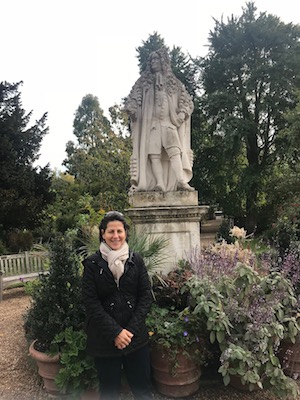



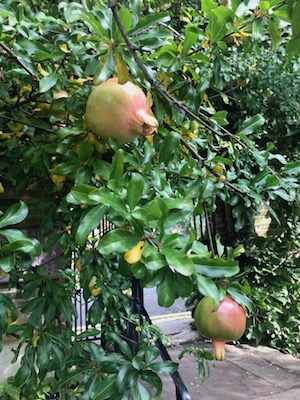

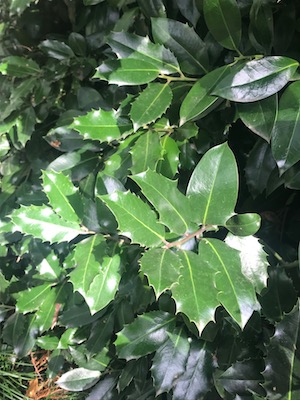

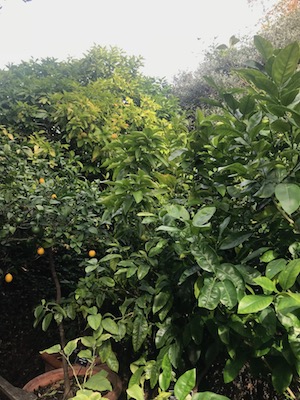
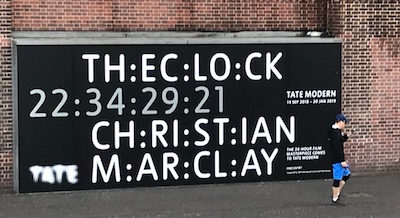

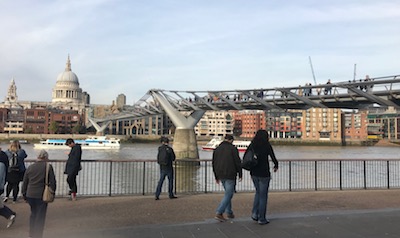




Comments